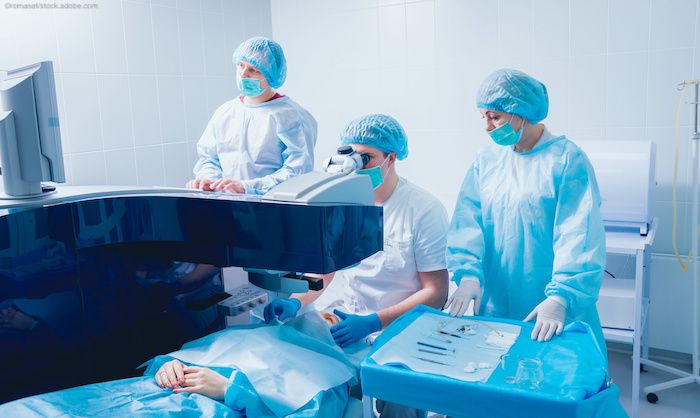Cataract surgery in patients with diabetes: No time like the present

Cataract surgery should not be delayed based on the HbA1c levels in patients with diabetic eye disease.
A recent study of outcomes after cataract surgery indicated that patients with diabetic retinopathy (DR) with no previous macular disorders achieved 20/20 vision, and the line gain was the same as patients without diabetes who underwent cataract surgery, according to Geraldine R. Slean, MD, MS.
The investigators conducted a retrospective cohort study that included patients at Kaiser Permanente Northern California who presented for cataract surgery from June 2010 to May 2015. Patients were enrolled for at least 1 year before surgery.
Patients were excluded who had macular edema preoperatively or type 1 diabetes, had undergone cataract surgery by a retina or oculoplastics specialist, or if endophthalmitis was diagnosed within the previous year.
The study included 102,050 eyes of 65,370 patients who underwent uncomplicated phacoemulsification. Best-corrected visual acuity (BCVA) had been recorded up to 1 year preoperatively.
The earliest postoperative BCVA was measured between 3 weeks to 1 year postoperatively, said Dr. Slean, who is an ophthalmology resident, California Pacific Medical Center, San Francisco, and will be joining Kaiser Permanente upon graduation.
Of the total number of patients, 22,360 (34%) of the study patients had diabetes; 81% had diabetes without DR, 15% had diabetes with nonproliferative diabetic retinopathy (NPDR) of varying severities, and 4% had diabetes with PDR. The duration of diabetes was less than 10 years in 37% and 10 years or longer in 41%.
Insulin was used by 20% of patients. Only 41% of patients obtained a hemoglobin A1C (HbA1c) measurement 90 days preoperatively; of these, 13% had a HbA1c value of <6.5%, 25% from 6.5 to 8.9%, and 4% ï³ 9.0%, she noted.
Study results
The average preoperative BCVA of the first eye to undergo phacoemulsification was 20/68 in patients without diabetes, and the average postoperative BCVA was 20/25. In patients with diabetes without DR the respective BCVA values were 20/71 and 20/26.
In patients with mild or moderate NPDR, the postoperative values were 20/27 and 20/28, respectively; in those with severe NPDR and PDR, the respective postoperative BCVAs were 20/30 and 20/34, Dr. Slean noted.
“The average change in the logarithm of the minimum angle of resolution [logMAR] was similar for patients with and without diabetes,” she said.
The logMAR values ranged from -0.43 to -0.50 among the groups.
All patients with and without diabetes had an average improvement of four lines of BCVA after phacoemulsification.
The adjusted odds ratio (OR) of postoperative BCVA of 20/25 or worse versus 20/20 or better in patients with diabetes without DR was 1.01.
“Patients with diabetic mellitus without DR had the same odds of achieving excellent 20/20 vision postoperatively as patients without diabetes,” Dr. Slean said.
In contrast, she pointed out, eyes with DR had increased odds of achieving a postoperative BCVA of 20/25 or worse with increasing severity of DR, i.e., the more severe the retinopathy the lower the odds of achieving 20/20 vision postoperatively.
For example, the patients with PDR had an OR of 3.56 compared with patients with no diabetes.
The adjusted OR was elevated slightly in association with a longer disease duration, i.e., longer than 10 years, OR, 1.14. Higher ORs also were seen with patients taking insulin, 1.12, compared with patients not using insulin.
However, Dr. Slean noted, the HbA1c level was not related to the odds of a postoperative VA of 20/25 or worse.
Worse preoperative BCVA was associated with increasing odds of a postoperative BCVA of 20/25 or worse. Older age, female sex, non-white race/ethnicity, body mass index below 18.5 kg/m2, systemic hypertension, cardiovascular disease, and an ocular comorbidity were associated with more than a 10% increased odds of a postoperative BCVA of 20/25 or worse.
The change in logMAR BCVA resulting from phacoemulsification was not affected significantly by the stage of DR, diabetes duration, insulin use, or systemic comorbidities. Increased patient age and ocular comorbidities were associated with less improvement in logMAR BCVA.
“Patients with diabetes with no DR were just as likely to achieve 20/20 postoperative BCVA as were the patients without diabetes,” Dr. Slean said. “Patients with DR were less likely to achieve 20/20 BCVA postoperatively compared with patients without DR with a trend toward worsening of the postoperative BCVA with the severity of the DR."
All patients, i.e., those with and without diabetes and those with and without DR, gained four lines of vision after cataract surgery. Attaining a BCVA of 20/20 postoperatively was not associated with the preoperative HbA1c level.
“Cataract surgery should not be delayed based on the HbA1c levels,” Dr. Slean said. “Timely cataract surgery can be of great benefit to patients with diabetes irrespective of the HbA1c levels.”
Disclosures:
Geraldine R. Slean, MD, MS.
E: gslean@yahoo.com
Dr. Slean has no financial interest in any aspect of this report. She was joined in this study by Liyan Liu, MD; Lisa Herrinton, MD; Stacey Alexeeff, MD; Andrew Karter, MD; Laura Amsden, MD; James Carolan, MD; and Neal Shorstein, MD.
Newsletter
Keep your retina practice on the forefront—subscribe for expert analysis and emerging trends in retinal disease management.